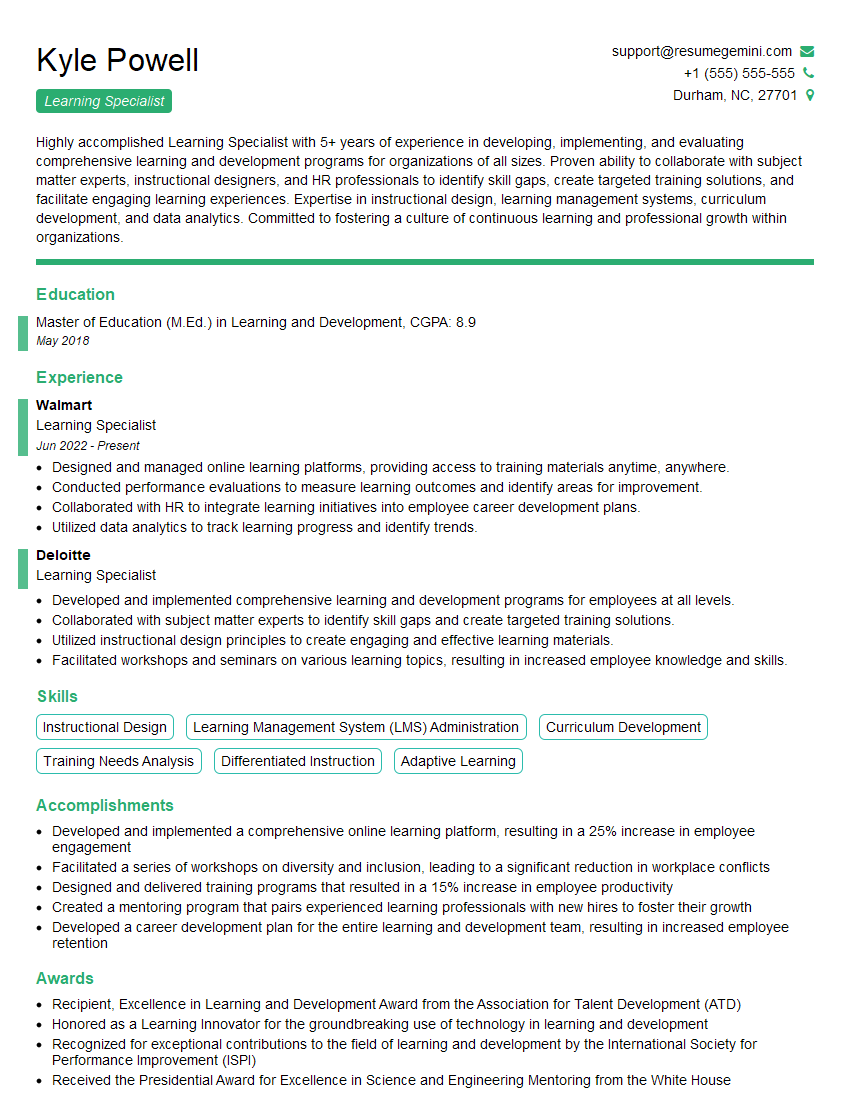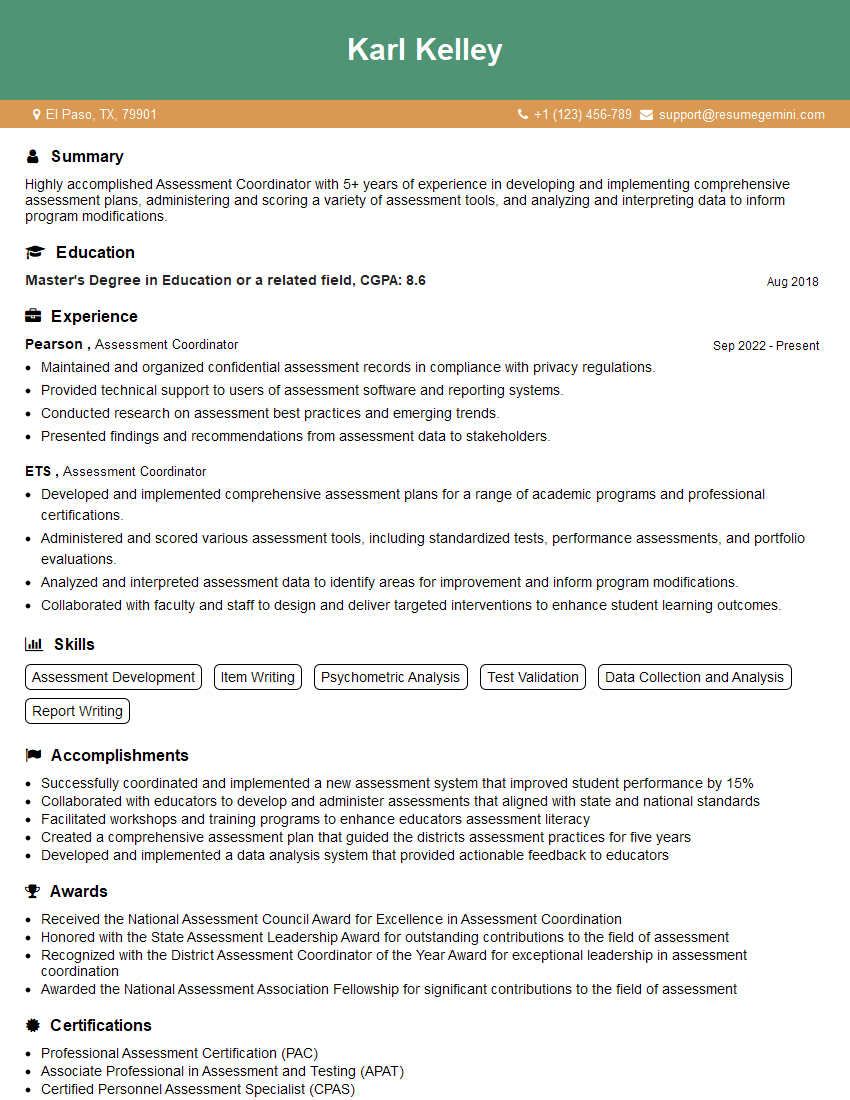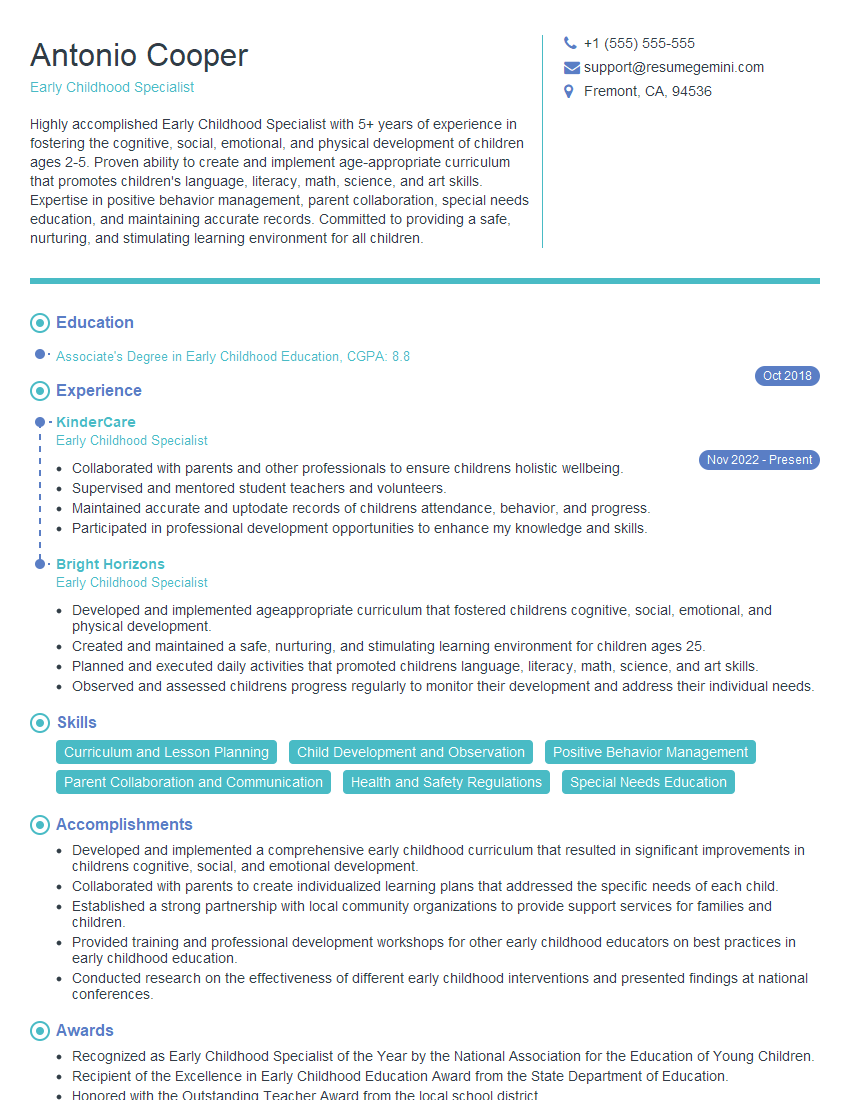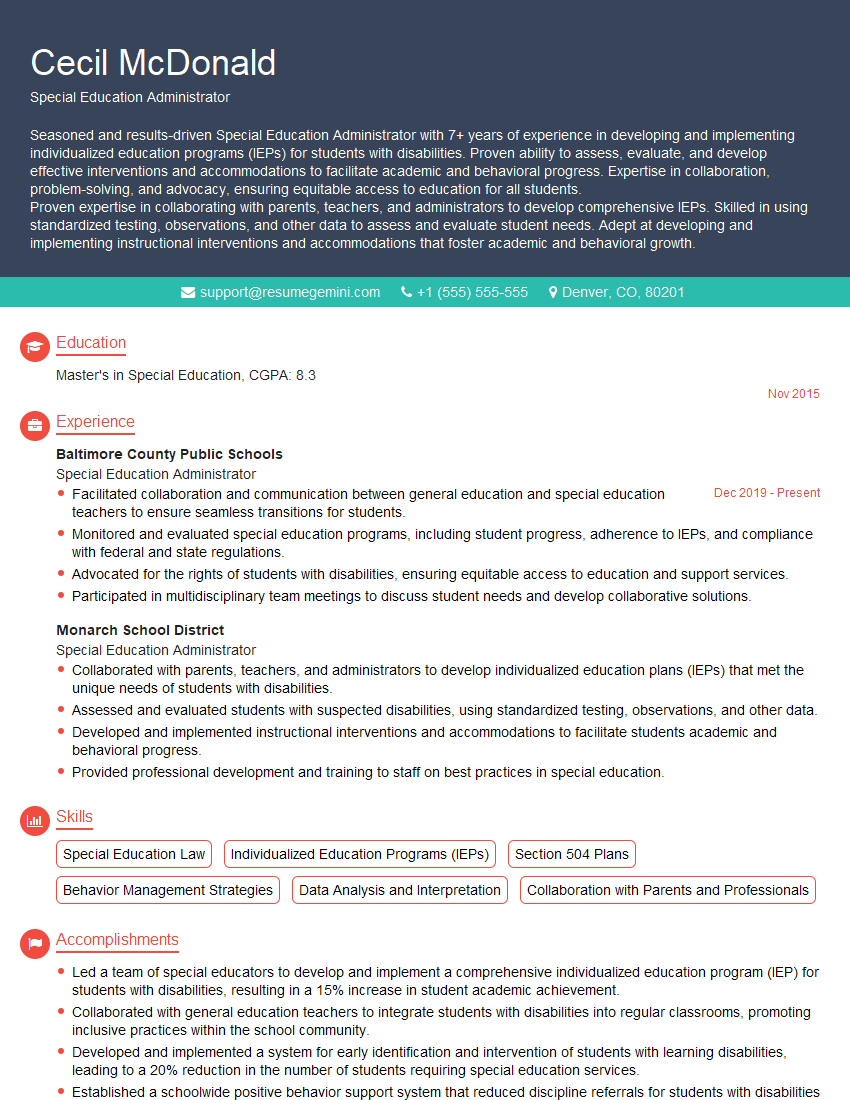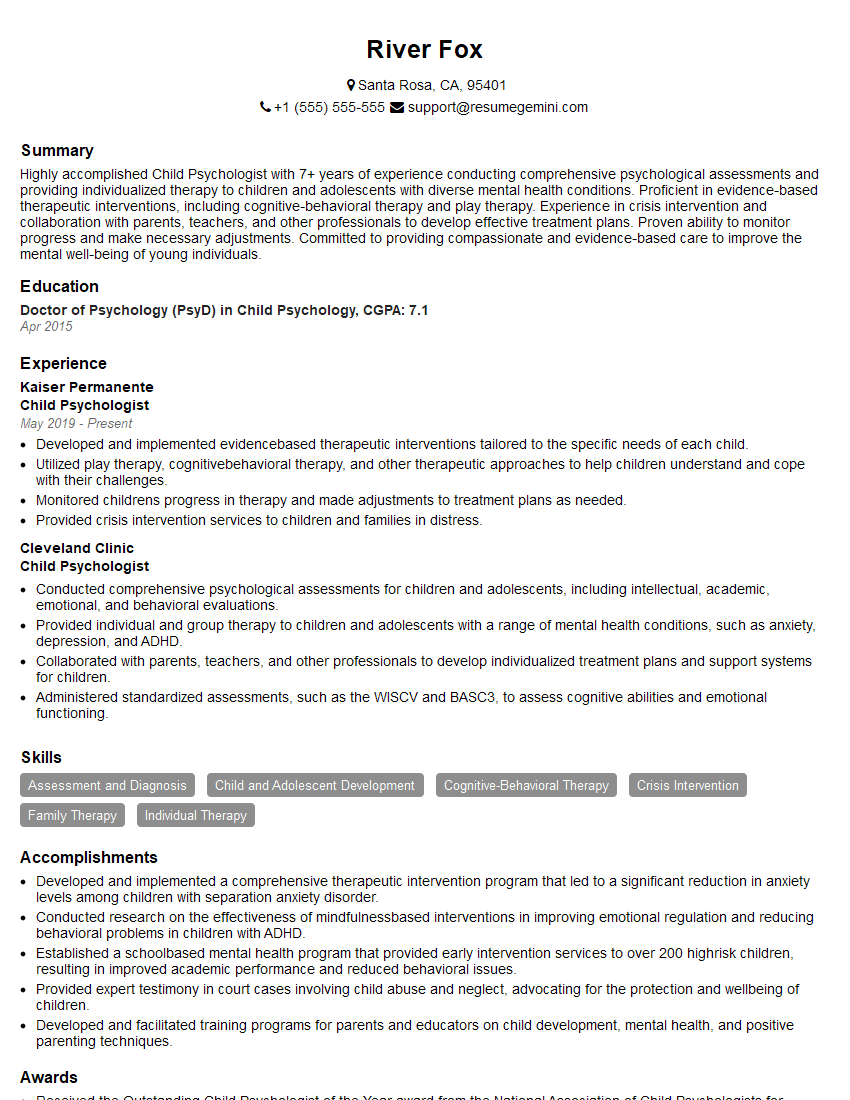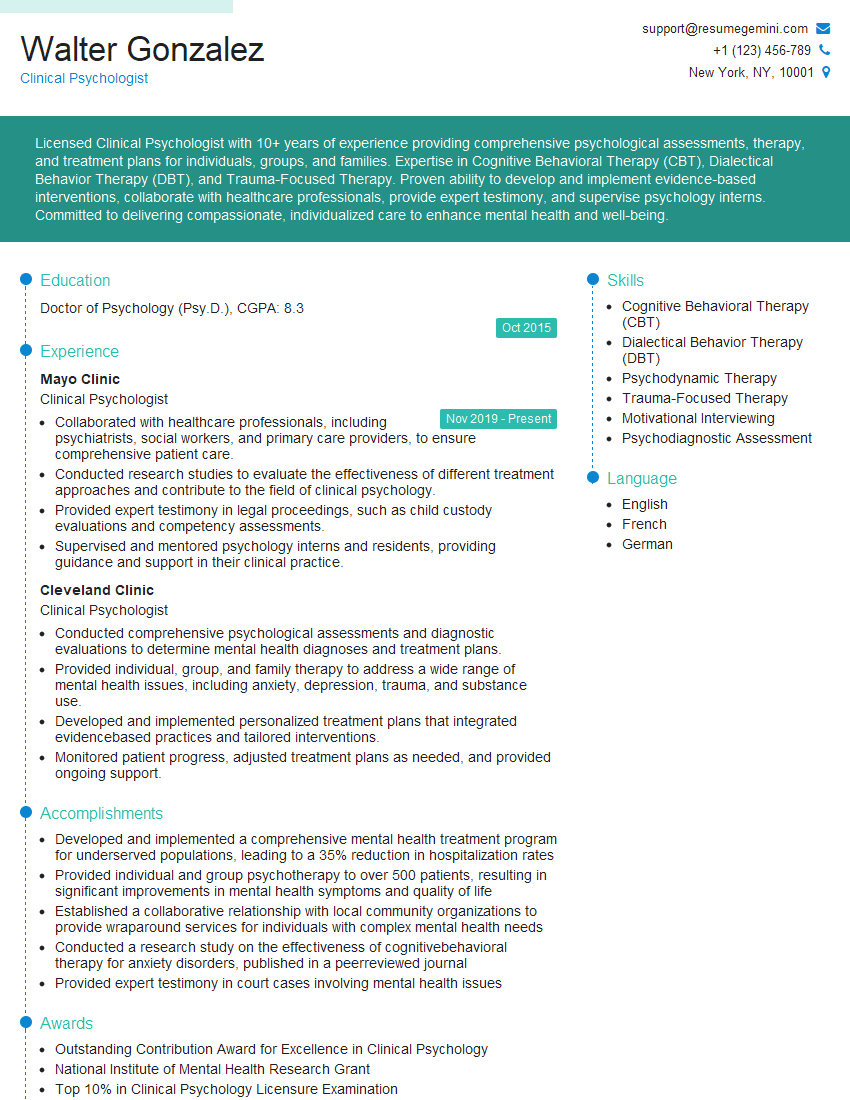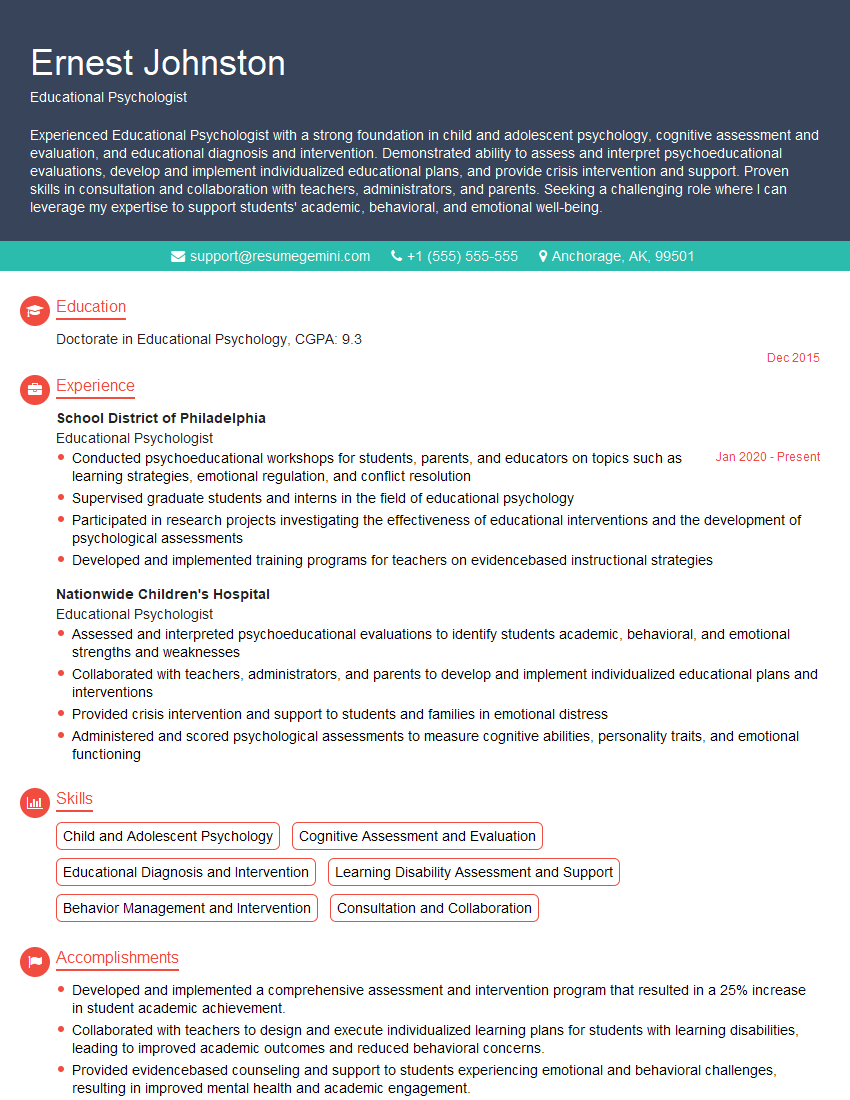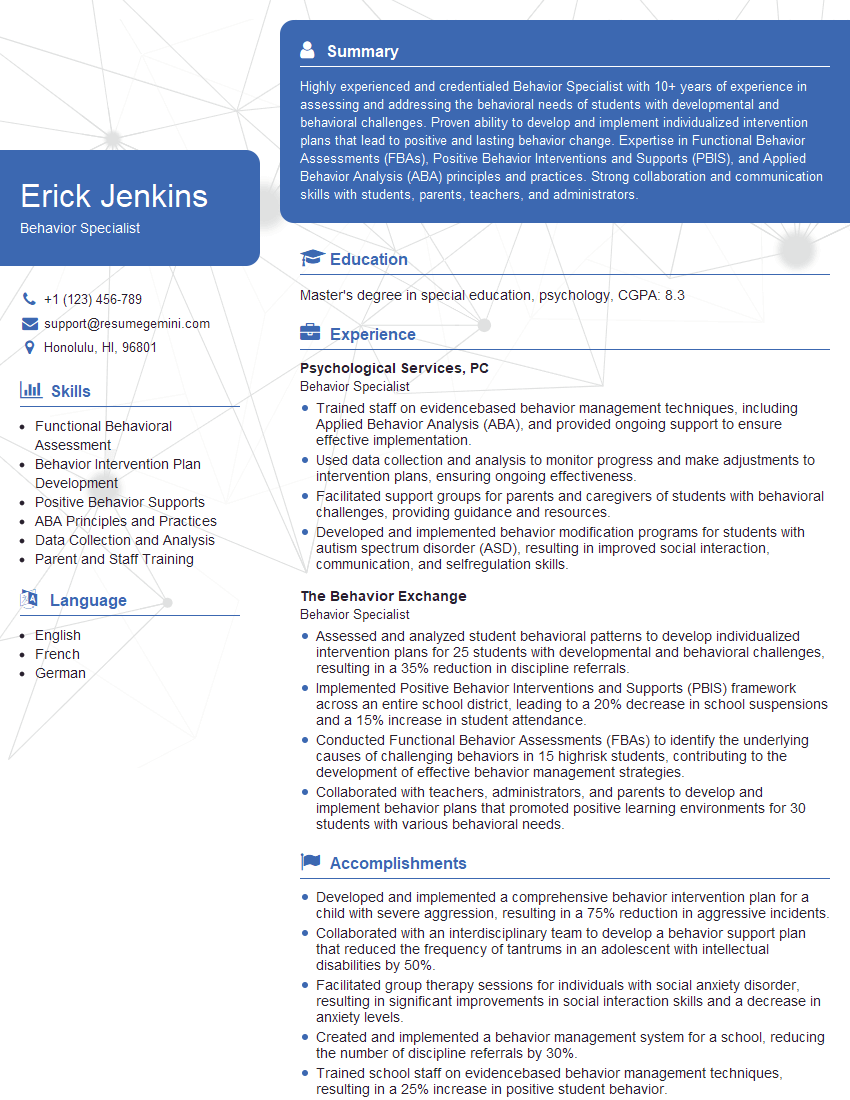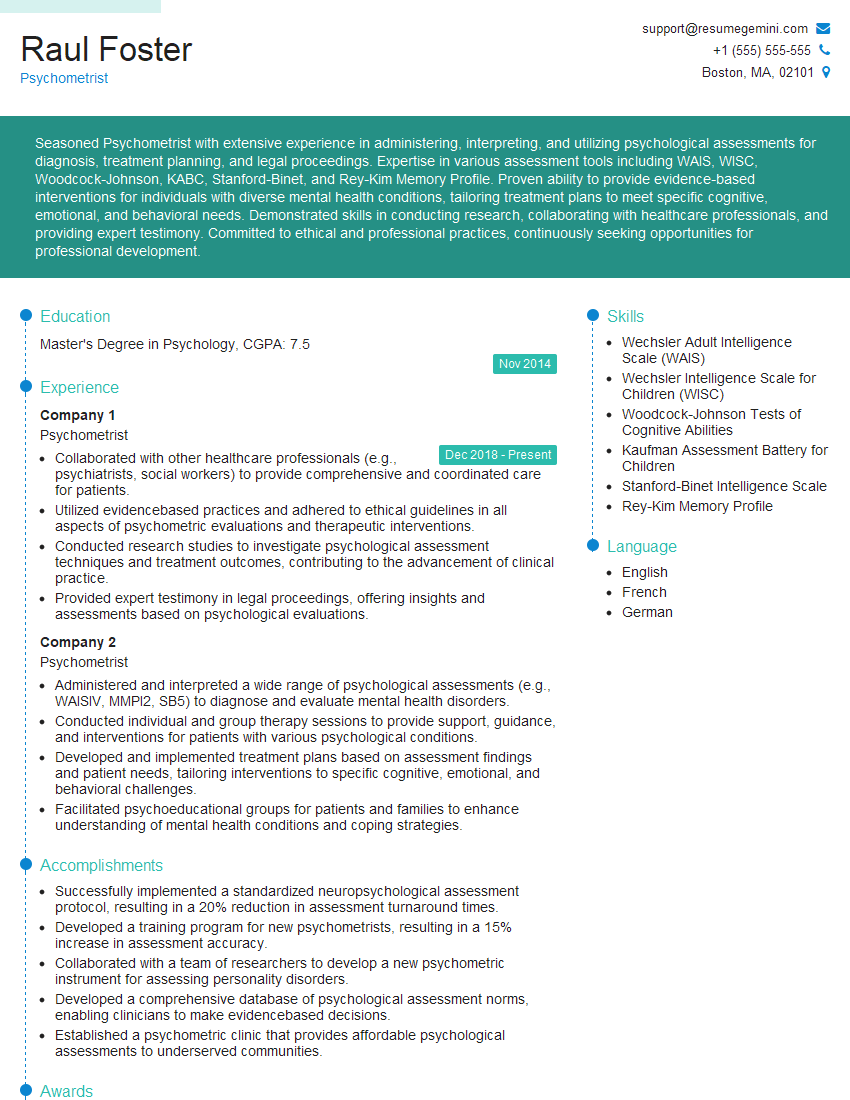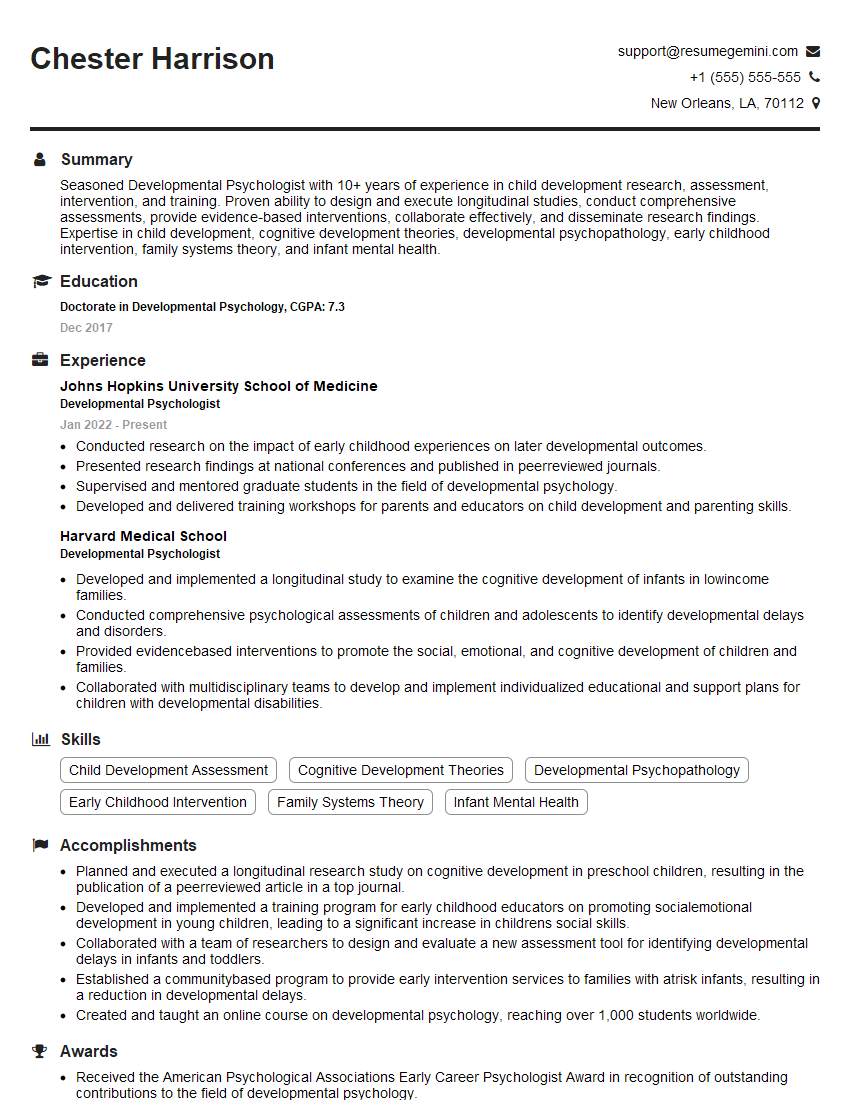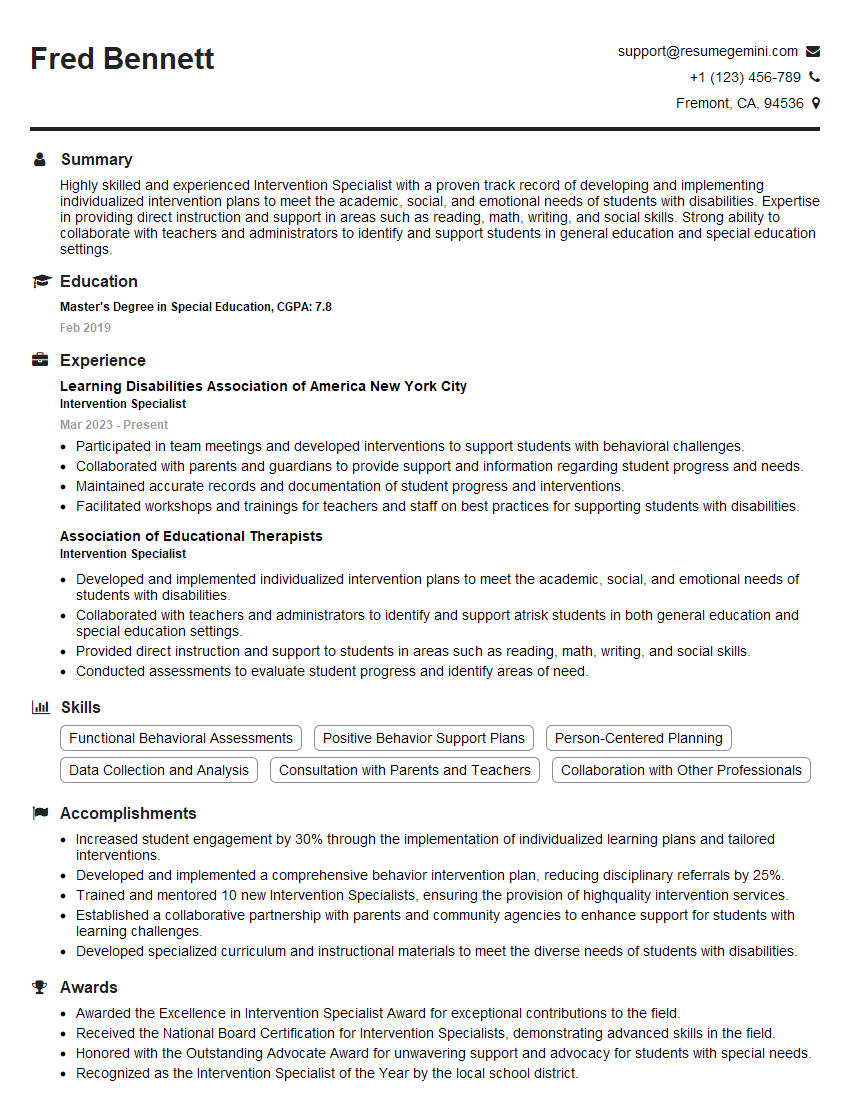Cracking a skill-specific interview, like one for Psychoeducational Assessments, requires understanding the nuances of the role. In this blog, we present the questions you’re most likely to encounter, along with insights into how to answer them effectively. Let’s ensure you’re ready to make a strong impression.
Questions Asked in Psychoeducational Assessments Interview
Q 1. Describe the process of administering the WISC-V.
Administering the WISC-V, the Wechsler Intelligence Scale for Children – Fifth Edition, involves a structured process designed to assess a child’s cognitive abilities. It begins with building rapport with the child, creating a comfortable and encouraging testing environment. The examiner then follows a standardized protocol, administering subtests in a specific order. These subtests tap into different cognitive domains, such as verbal comprehension, perceptual reasoning, working memory, processing speed, and fluid reasoning. Each subtest involves a series of tasks, carefully graded in difficulty. The examiner meticulously records the child’s responses, adhering strictly to the test manual’s instructions. After completing all subtests, the examiner scores the responses and generates a comprehensive report, including overall IQ scores (Full Scale IQ, Verbal Comprehension Index, Perceptual Reasoning Index, Processing Speed Index, Working Memory Index) and subtest scores. This detailed report provides insights into the child’s cognitive strengths and weaknesses. For example, a child might excel in verbal comprehension but struggle with processing speed. This information is crucial for educational planning and intervention.
Throughout the process, the examiner remains objective, avoiding any bias in their interactions and scoring. The goal is to obtain an accurate representation of the child’s cognitive abilities, unaffected by extraneous factors. Careful attention to detail and adherence to standardized procedures are critical to ensure the validity and reliability of the assessment.
Q 2. Explain the differences between achievement and aptitude tests.
Achievement tests and aptitude tests, while both used in psychoeducational assessments, measure different things. Achievement tests assess what a person has already learned in specific academic areas, such as reading, math, and writing. Think of it like a pop quiz – it measures your current knowledge and skills in a subject. Examples include the Woodcock-Johnson IV Tests of Achievement and the Wide Range Achievement Test (WRAT-4). Aptitude tests, on the other hand, aim to predict a person’s future learning potential or ability to acquire new skills. The WISC-V, for instance, is an aptitude test, estimating a child’s overall cognitive capacity and potential for academic success. It’s like predicting how well you might do in a new class based on your general learning abilities. The key difference lies in what they measure: achievement tests measure past learning, while aptitude tests measure potential for future learning.
In practice, we often use both types of tests together. For example, if a student is struggling academically, we might use an achievement test to identify their specific areas of weakness (e.g., decoding skills in reading) and an aptitude test to determine their overall cognitive abilities and identify any potential learning disabilities that might be contributing to their difficulties. This combined information helps develop a comprehensive understanding of the student’s academic profile and guide interventions effectively.
Q 3. What are the ethical considerations in administering psychoeducational assessments?
Ethical considerations in administering psychoeducational assessments are paramount. The core principle is to ensure the well-being and rights of the individual being assessed. This encompasses several key areas:
- Confidentiality: All assessment information must be kept strictly confidential, shared only with authorized individuals (e.g., parents with parental consent, school officials with appropriate authorization). Protecting sensitive information is essential.
- Informed Consent: Before starting any assessment, informed consent must be obtained from the individual (if they are of age) or their legal guardian. This means they understand the purpose of the assessment, the procedures involved, and how the information will be used. Consent should be freely given, without coercion.
- Competence: Only qualified and licensed professionals with appropriate training and experience should conduct psychoeducational assessments. This ensures that the assessments are administered and interpreted correctly, leading to accurate and reliable results.
- Cultural Sensitivity: Assessments should be culturally appropriate and sensitive to the individual’s background and experiences. Using assessments that are not culturally sensitive could lead to inaccurate and biased results.
- Test Security: Maintaining the integrity of the test materials is crucial. Preventing unauthorized access or disclosure of test items is vital to the validity of the assessments.
- Appropriate Use of Results: Assessment results should be used responsibly and ethically. They should inform educational planning and interventions, and never used for purposes outside of their intended scope, such as labeling or stigmatizing individuals.
Adherence to these ethical guidelines ensures that psychoeducational assessments are conducted in a fair, accurate, and responsible manner, benefiting the individuals being assessed and upholding the integrity of the profession.
Q 4. How do you interpret discrepancies between achievement and IQ scores?
Discrepancies between achievement and IQ scores are often a significant finding in psychoeducational assessments. A significant difference, often defined using specific statistical criteria, can suggest a learning disability or other underlying cognitive or emotional factors. For example, a child with a high IQ score (indicating strong cognitive potential) but significantly lower achievement scores in reading might indicate a specific learning disability in reading (dyslexia). The pattern of discrepancies helps pinpoint the areas needing intervention.
Interpreting these discrepancies is complex and requires careful consideration of various factors, including the child’s developmental history, medical history, and classroom observations. It is crucial to consider the magnitude of the discrepancy, the specific areas of strength and weakness, and the child’s overall academic functioning. It’s not simply a matter of comparing numbers; it’s about understanding the underlying reasons for the differences. Further investigation, such as reviewing educational records and conducting interviews, is often needed to form a complete picture. A multidisciplinary approach, involving teachers, parents, and other professionals, is often the most effective way to address the identified learning needs.
Q 5. What are the common signs of ADHD as identified through psychoeducational assessments?
Psychoeducational assessments can help identify several common signs of ADHD (Attention-Deficit/Hyperactivity Disorder). While a diagnosis requires a comprehensive evaluation by a qualified professional, assessment results can provide supporting evidence. Common signs revealed through these assessments include:
- Inconsistent performance on tests of attention and concentration: Children with ADHD often show variability in their performance across different tasks, reflecting difficulty sustaining attention and focus.
- Difficulty with working memory: Challenges in holding information in mind and manipulating it for tasks may appear on assessments measuring working memory.
- Impaired processing speed: Slower performance on tasks requiring quick processing of information is a common indicator.
- Difficulties with executive functions: Executive functions, such as planning, organization, and self-regulation, are often impaired in children with ADHD and can manifest in poor test-taking strategies or difficulty following instructions.
- Behavioral observations during the assessment: The examiner might note fidgeting, restlessness, difficulty staying seated, or impulsivity during the assessment process.
It’s crucial to remember that these are just indicators, and a diagnosis of ADHD cannot be made solely on the basis of psychoeducational assessment data. A comprehensive evaluation, including clinical interviews and observations, is necessary to make a proper diagnosis.
Q 6. Discuss the use of adaptive testing in psychoeducational assessment.
Adaptive testing is a sophisticated method used in psychoeducational assessments to tailor the difficulty of test items to the individual’s performance. Unlike traditional fixed-item tests where everyone receives the same items, adaptive tests adjust the difficulty level in real-time. If the examinee answers correctly, the next item is more difficult; if they answer incorrectly, the next item is easier. This ensures that the test is neither too easy nor too hard, efficiently targeting the individual’s ability level. This approach offers several advantages:
- Increased precision: Adaptive testing provides a more precise measurement of ability, as it focuses on the examinee’s specific level of performance.
- Reduced testing time: By efficiently focusing on the individual’s ability level, adaptive tests can shorten the overall assessment time.
- Improved motivation: The tailored difficulty levels can maintain the examinee’s motivation and engagement throughout the assessment.
- Minimized frustration: By avoiding overly difficult items that might lead to frustration, adaptive testing creates a more positive testing experience.
Many modern psychoeducational tests, including some versions of achievement and cognitive ability tests, now utilize adaptive testing methodologies, leading to more accurate and efficient assessments.
Q 7. Explain your approach to providing feedback to parents regarding assessment results.
Providing feedback to parents on assessment results is a critical part of the psychoeducational assessment process. My approach is to ensure clear, empathetic, and collaborative communication. I begin by creating a comfortable and supportive environment for parents to ask questions and express concerns. I present the findings in plain language, avoiding technical jargon, and using analogies and examples to make complex information easily understandable. I focus on explaining the child’s strengths and weaknesses in concrete, practical terms, relating them to their academic performance and daily life. For instance, instead of saying “The child has a low processing speed,” I might say, “The child takes a little longer to complete tasks that require quick thinking, like following multi-step instructions or writing quickly.”
I collaborate with parents to develop a shared understanding of the assessment results and their implications. We discuss potential interventions, strategies, and resources that could help the child succeed. This process involves active listening, acknowledging parental concerns, and emphasizing their role in supporting their child’s learning. The goal is not only to deliver information but to empower parents to advocate for their child and work collaboratively with school professionals to create an effective learning plan. I also ensure that parents receive a written copy of the report and have ample opportunity to discuss any questions or concerns they may have.
Q 8. How do you ensure the cultural fairness of psychoeducational assessments?
Ensuring cultural fairness in psychoeducational assessments is paramount to avoid bias and obtain accurate results. It’s not simply about translating tests; it’s about understanding the cultural context in which a child learns and develops. This involves several key strategies:
Selecting culturally appropriate assessment tools: Using assessments that are standardized on diverse populations and minimize reliance on culturally specific knowledge. For example, avoiding vocabulary or imagery that might be unfamiliar to a child from a particular cultural background.
Using multiple assessment methods: Relying on a variety of methods like observations, interviews with parents and teachers, and informal assessments, in addition to standardized tests. This provides a more holistic and nuanced picture of the child’s abilities.
Considering the child’s language proficiency: If a child is not a native English speaker, assessments should be administered in their primary language or with appropriate accommodations like interpreters. We must be mindful of the impact of language barriers on performance.
Understanding cultural differences in learning styles and communication: Some cultures value collaborative learning while others emphasize individual achievement. Understanding these differences allows for a more sensitive and effective assessment process. A child who thrives in a collaborative setting might underperform on a traditionally individual assessment.
Providing a culturally sensitive environment: The assessment environment should be comfortable and non-threatening for the child. This includes ensuring the assessor is sensitive to the child’s cultural background and communication style.
For example, I once worked with a student from a refugee background who struggled with standardized tests due to trauma and unfamiliarity with Western-style schooling. By using a combination of observation, informal assessments and interviews, I was able to accurately assess their cognitive abilities and learning strengths, resulting in a more appropriate educational plan.
Q 9. What are some common limitations of psychoeducational assessments?
Psychoeducational assessments, while valuable, have limitations. It’s crucial to interpret results cautiously, considering these factors:
Test bias: As mentioned, cultural and linguistic factors can influence test results, leading to inaccurate conclusions. Tests might inadvertently favor certain groups.
Snapshot in time: Assessments provide a snapshot of a child’s abilities at a particular point in time. A child’s performance can fluctuate due to various factors like stress, illness, or even the assessor’s rapport with the child.
Limited scope: Tests primarily measure cognitive abilities and academic skills. They may not fully capture other factors influencing academic performance, like motivation, emotional regulation, or social-emotional learning.
Over-reliance on standardized scores: Focusing solely on standardized test scores without considering other qualitative data can lead to misinterpretations. A score is just one piece of the puzzle.
Subjectivity in interpretation: While standardized tests aim for objectivity, interpretation of results can be subjective. Different clinicians might draw different conclusions from the same data.
For instance, a student might score poorly on a reading comprehension test due to anxiety, not necessarily a reading disability. It’s essential to consider the context and incorporate other information to develop a comprehensive understanding.
Q 10. Describe your experience with different types of assessment instruments (e.g., Wechsler Scales, Woodcock-Johnson, KTEA).
I have extensive experience administering and interpreting various assessment instruments, including the Wechsler Scales, Woodcock-Johnson Tests of Achievement, and the KTEA (Kaufman Test of Educational Achievement).
Wechsler Scales (WISC-V, WAIS-IV): I use these to assess intelligence, including verbal comprehension, perceptual reasoning, working memory, and processing speed. Understanding the different index scores helps identify cognitive strengths and weaknesses that may be impacting learning.
Woodcock-Johnson IV: This comprehensive battery provides detailed information on cognitive abilities and achievement in various academic areas like reading, math, and written expression. I find its diagnostic precision particularly useful in identifying specific learning disabilities.
KTEA-III: I utilize KTEA to assess achievement in core academic areas. Its strengths lie in its relatively shorter administration time and clear diagnostic criteria, making it efficient for identifying areas requiring intervention.
My experience includes selecting the appropriate instrument based on the referral question and the child’s age and developmental level. I’m proficient in scoring, interpreting the results, and integrating them with other data to create a comprehensive report.
Q 11. How do you differentiate between a learning disability and other factors influencing academic performance?
Differentiating between a learning disability and other factors affecting academic performance requires a comprehensive assessment process. A learning disability is characterized by a significant discrepancy between a student’s potential (cognitive abilities) and actual academic achievement, despite adequate instruction. It’s not simply about performing poorly; it’s about a persistent struggle despite interventions.
Here’s how I approach this differentiation:
Rule out other factors: First, I meticulously assess for other potential contributors such as vision or hearing impairments, emotional or behavioral issues, lack of appropriate instruction, inadequate educational resources, language barriers, and socio-economic factors. Often, these are addressed first before diagnosing a learning disability.
Cognitive testing: Using intelligence tests like the WISC-V to evaluate cognitive abilities. This helps establish a baseline of intellectual functioning.
Achievement testing: Using achievement tests like the Woodcock-Johnson or KTEA to measure current academic performance in specific areas like reading, math, and writing. A significant discrepancy between cognitive ability and achievement suggests a possible learning disability.
Response to intervention (RTI): RTI data shows how a student responds to increasingly intensive educational interventions. A lack of improvement despite interventions supports the diagnosis of a learning disability.
Qualitative data: Information from teachers, parents, and observations is crucial. It paints a comprehensive picture of the student’s learning behaviors, strengths, and challenges beyond test scores.
For example, a student might score poorly on math tests due to anxiety about math class or a lack of prior instruction. However, if their cognitive abilities are high, and they consistently struggle in math despite appropriate interventions, it might suggest a specific learning disability in mathematics.
Q 12. Explain the role of observation in the psychoeducational assessment process.
Observation plays a vital role in psychoeducational assessments, providing invaluable qualitative data that complements standardized test results. It allows for a more holistic understanding of the student’s learning behaviors and challenges.
During the assessment process, I observe the student in various settings, including:
Classroom observation: Observing the student’s attention span, engagement, participation, and interaction with peers and teachers in the classroom setting.
Individual testing sessions: Observing the student’s approach to tasks, problem-solving strategies, frustration tolerance, and motivation during testing.
Play-based observation (for younger children): Observing the child’s play behaviors, social interactions, and problem-solving skills in a less structured setting.
I document these observations carefully, noting specific behaviors and interactions. For example, I might note a student’s difficulty staying focused, frequent fidgeting, or struggles with organization. This observational data is integrated with test results to build a more complete and accurate picture of the student’s strengths and needs.
Q 13. Discuss the importance of integrating assessment results with other data sources.
Integrating assessment results with other data sources is essential for a comprehensive and accurate understanding of a student’s learning profile. Standardized tests are just one piece of the puzzle; a complete picture requires contextual information.
Data sources I integrate include:
Teacher reports: Teachers provide valuable insights into the student’s classroom behavior, academic performance, response to interventions, and learning styles.
Parent interviews: Parents offer valuable information on the student’s developmental history, medical information, home environment, and learning habits.
Student self-reports: Older students can provide insights into their own learning experiences, strengths, and challenges.
Review of educational records: Reviewing previous academic records and intervention reports provides valuable historical data.
Medical records (when relevant): Medical information can shed light on potential factors impacting learning, like ADHD or other neurological conditions.
For example, a low score on a reading comprehension test might be explained by a teacher’s report that the student struggles with attention and organizational skills. By integrating all these sources, we gain a much clearer picture of the student’s strengths and needs and can provide more effective recommendations.
Q 14. How do you adapt your assessment approach for students with diverse learning needs?
Adapting my assessment approach for students with diverse learning needs is critical for ensuring accurate and fair evaluations. This involves several considerations:
Accommodations: Providing necessary accommodations such as extended time, breaks, use of assistive technology, or alternative formats for presenting information (e.g., auditory instead of visual).
Modifications: Adjusting the assessment itself when necessary, such as simplifying instructions or reducing the complexity of tasks. This should be done cautiously and only when absolutely necessary to avoid compromising the validity of the results.
Selecting appropriate assessments: Choosing assessments that are suitable for the student’s cognitive and linguistic abilities. This might involve using age-appropriate tests or tests designed for students with specific learning disabilities.
Using alternative assessment methods: Supplementing standardized tests with alternative assessment methods such as portfolios, observations, and performance-based tasks to obtain a more comprehensive understanding of the student’s abilities.
Culturally responsive assessment: Employing culturally sensitive practices as discussed earlier to ensure the student feels comfortable and confident during the assessment.
For instance, a student with ADHD might require frequent breaks and a quieter testing environment. A student with a visual impairment might need braille or large print materials. By carefully adapting my approach, I ensure that I obtain a valid and accurate assessment of the student’s abilities.
Q 15. What are your strategies for managing challenging behaviors during assessments?
Managing challenging behaviors during psychoeducational assessments requires a multifaceted approach prioritizing the student’s well-being and the integrity of the assessment. My strategy begins with proactive preparation. This includes thoroughly reviewing the student’s file to understand any known behavioral patterns or triggers. I create a comfortable and supportive testing environment, minimizing distractions and ensuring the student feels safe and respected.
During the assessment, I utilize flexible strategies. If a student becomes agitated, I might take short breaks, adjust the testing schedule, or rephrase instructions. I’m trained in de-escalation techniques, employing calm and reassuring language. For instance, if a student becomes frustrated with a task, I might offer positive reinforcement and encouragement, breaking down complex tasks into smaller, more manageable steps. Severe behavioral issues may necessitate consultation with the student’s school psychologist or other support professionals, possibly postponing parts of the assessment.
Documentation is crucial. I meticulously record any deviations from standard procedures, along with the strategies employed and their effectiveness. This ensures transparency and allows for informed decision-making regarding subsequent assessment sessions or interpretations.
Career Expert Tips:
- Ace those interviews! Prepare effectively by reviewing the Top 50 Most Common Interview Questions on ResumeGemini.
- Navigate your job search with confidence! Explore a wide range of Career Tips on ResumeGemini. Learn about common challenges and recommendations to overcome them.
- Craft the perfect resume! Master the Art of Resume Writing with ResumeGemini’s guide. Showcase your unique qualifications and achievements effectively.
- Don’t miss out on holiday savings! Build your dream resume with ResumeGemini’s ATS optimized templates.
Q 16. Describe your experience with report writing and interpreting assessment findings.
Report writing and interpretation are integral to the psychoeducational assessment process. My reports are structured to be clear, concise, and readily understandable by parents, educators, and other professionals. They begin with a brief overview of the referral question, followed by a detailed description of the assessment procedures employed, including the specific tests administered.
The core of the report presents a comprehensive analysis of the assessment findings, focusing on the student’s strengths and weaknesses across various cognitive domains. I avoid technical jargon wherever possible, using plain language to describe complex concepts. For example, instead of stating ‘significant standard score discrepancy,’ I might write ‘the student’s performance in reading is considerably lower than their overall cognitive ability.’
Interpretation goes beyond simply presenting the numbers. I carefully integrate the test data with information obtained from interviews with the student, parents, and teachers. This holistic approach enables me to develop a nuanced understanding of the student’s learning profile and inform recommendations for educational interventions. I always conclude by offering specific, actionable recommendations tailored to the student’s unique needs and circumstances.
Q 17. How do you ensure confidentiality and the secure storage of assessment data?
Confidentiality and secure storage of assessment data are paramount. I strictly adhere to all relevant ethical guidelines and legal regulations, including HIPAA and FERPA. All assessment records are stored in locked cabinets, and electronic files are password-protected and encrypted. Access is strictly limited to authorized personnel only. I never share assessment data with unauthorized individuals or organizations.
Furthermore, I use de-identified data when presenting findings in professional settings, for example, during workshops or conferences. When sharing information with parents or educators, I ensure that communication is sensitive to the student’s privacy, only sharing information relevant to the referral question and educational planning. I obtain informed consent from parents or guardians prior to conducting any assessment procedures and explain the confidentiality protocols clearly.
Q 18. What professional development activities have you undertaken to enhance your assessment skills?
Continuous professional development is critical for maintaining high standards in psychoeducational assessment. I regularly attend workshops and conferences focused on advancements in assessment techniques, best practices, and ethical considerations. For example, I recently completed a training on the latest updates to the WISC-V and its implications for diverse learners. I actively seek supervision and mentorship from experienced professionals, discussing challenging cases and refining my assessment approach.
I also engage in self-directed learning, regularly reviewing current research and literature in the field of psychoeducational assessment. I stay current with new test releases and updates on diagnostic criteria. This commitment to ongoing learning allows me to provide the most accurate, effective, and ethically sound assessment services possible.
Q 19. Discuss your experience with different theoretical frameworks used in psychoeducational assessment.
My work draws upon several theoretical frameworks in psychoeducational assessment, including cognitive, developmental, and psychodynamic perspectives. The cognitive perspective informs my understanding of how students process information, solve problems, and learn. This is particularly relevant when interpreting measures of intelligence, working memory, and academic achievement.
Developmental frameworks help me understand how learning and cognitive abilities unfold across different age stages. This is essential for interpreting assessment results in context of the student’s developmental trajectory. For example, I consider developmental milestones when assessing younger children and adjust expectations accordingly. Psychodynamic insights are helpful in understanding the emotional and motivational factors that may influence a student’s performance, informing a comprehensive and holistic assessment.
A good assessment integrates these different perspectives, leading to a rich understanding of the individual’s learning profile and not simply a collection of test scores.
Q 20. Explain how you would address potential biases in test administration and interpretation.
Addressing potential biases in test administration and interpretation is crucial for ensuring fair and equitable assessment. I’m acutely aware of the potential for cultural, linguistic, and socioeconomic biases to influence test performance. I mitigate these biases through several strategies.
Firstly, I carefully select assessments that are culturally appropriate and have been validated across diverse populations. I use tests that minimize reliance on language and cultural knowledge when possible. When language barriers exist, I use interpreters or employ alternative assessment methods. During the administration, I create a welcoming environment to reduce test anxiety, particularly amongst students from marginalized backgrounds. For example, I might adjust my communication style based on a child’s comfort level.
Finally, I interpret assessment results cautiously, considering the student’s background and experiences. I avoid making generalizations or drawing conclusions based on limited data. Instead, I focus on the student’s specific strengths and challenges, providing recommendations for interventions that address their individual needs.
Q 21. Describe a situation where you had to adapt your assessment procedures due to unforeseen circumstances.
In one instance, I was conducting an assessment with a student who experienced a sudden and severe anxiety attack mid-session. This was an unforeseen circumstance not reflected in the student’s file. Following my training in de-escalation techniques, I immediately stopped the assessment, providing a safe and supportive space for the student to calm down. I reassured the student, offering them water and a quiet moment to regain composure.
I didn’t attempt to push forward with the assessment, recognizing that continuing would be counterproductive and potentially harmful. Instead, I rescheduled the assessment for a later date, ensuring the student had ample time to recover and feel comfortable before resuming. I also discussed the incident with the student’s parents and teachers, collaboratively developing a plan to mitigate anxiety in future assessments. This included exploring strategies such as shorter testing sessions, frequent breaks, and a more relaxed testing environment. The flexibility in my approach ensured the student received a fair and valid assessment, while prioritizing their well-being.
Q 22. How do you communicate complex assessment results to individuals with varying levels of understanding?
Communicating complex psychoeducational assessment results requires tailoring the information to the individual’s understanding. I begin by assessing their comprehension level – this might involve observing their communication style, asking clarifying questions, and gauging their comfort with technical terminology.
For individuals with limited understanding, I use simple language, avoiding jargon. I rely heavily on visual aids like graphs and charts to illustrate key findings. For example, instead of saying “The student exhibited a significant standard score deficit in the area of phonological awareness,” I might say, “The test showed that the student has some challenges with the sounds in words, which can affect reading.”
With individuals who grasp more complex concepts, I can delve into statistical details and discuss the implications of specific test scores within the broader context of their academic and developmental history. I always ensure to answer their questions thoroughly and provide written summaries as well to aid comprehension and future reference.
Regardless of the audience, I prioritize a collaborative approach. I encourage questions and make sure they understand the next steps and resources available based on the assessment findings.
Q 23. What are your strategies for ensuring the validity and reliability of assessment results?
Ensuring the validity and reliability of assessment results is paramount. Validity refers to whether the assessment measures what it intends to measure, while reliability indicates the consistency of the results. I employ several strategies to ensure both.
- Using standardized, well-validated assessments: I select tests with strong psychometric properties, established norms, and evidence of validity and reliability for the specific population being assessed. This involves reviewing the test manuals and relevant research literature.
- Careful administration and scoring: I meticulously follow the standardized administration procedures outlined in the test manuals to minimize bias and ensure accurate scoring. This includes establishing rapport with the examinee, creating a comfortable testing environment, and adhering to strict time limits and instructions.
- Considering multiple sources of information: I integrate assessment data with information from teachers, parents, and other professionals. This helps to create a more comprehensive picture of the individual’s strengths and weaknesses and triangulate findings.
- Interpreting results within context: I never rely solely on a single test score. I consider the examinee’s age, developmental history, cultural background, and learning environment when interpreting the results to avoid misinterpretations.
- Regularly reviewing and updating my knowledge: I remain abreast of the latest research on assessment methods and best practices to ensure that I’m using the most reliable and valid instruments.
Q 24. Discuss your experience with using technology in psychoeducational assessment.
Technology plays an increasingly important role in psychoeducational assessment. I have extensive experience using various technological tools to enhance efficiency and effectiveness. This includes using computerized adaptive testing (CAT) platforms, which adjust the difficulty of test items based on the examinee’s responses. CAT platforms improve test efficiency by focusing on the examinee’s ability level.
I also utilize software for scoring and interpreting assessments, generating reports, and managing assessment data. These programs help streamline the process and reduce the potential for human error. Furthermore, I’m familiar with digital platforms for delivering interventions and monitoring progress after assessment. For example, I might utilize online resources for skill development based on the assessment’s findings.
However, I always prioritize the ethical considerations of technology in assessment. This includes ensuring that the technology is accessible and equitable for all examinees and protecting the confidentiality and security of assessment data.
Q 25. How do you stay current with best practices and emerging trends in psychoeducational assessment?
Staying current with best practices is crucial. I achieve this through several methods:
- Professional development: I regularly attend workshops, conferences, and webinars related to psychoeducational assessment. This allows me to learn about new assessment tools and techniques, as well as updates in diagnostic criteria and best practices.
- Continuing education: I pursue continuing education units (CEUs) to maintain my licensure and stay knowledgeable on the latest research and trends.
- Professional journals and publications: I regularly read peer-reviewed journals like the Journal of Psychoeducational Assessment and stay informed through professional organizations like the National Association of School Psychologists (NASP).
- Networking with colleagues: I collaborate and exchange information with other professionals in the field. This includes attending professional meetings, participating in online discussion groups, and consulting with colleagues on complex cases.
Q 26. Explain your understanding of different types of learning disabilities (e.g., dyslexia, dysgraphia, dyscalculia).
Learning disabilities are neurodevelopmental conditions that significantly affect academic skills. They are not caused by lack of intelligence or effort.
- Dyslexia: A specific learning disability in reading characterized by difficulties with phonological awareness, decoding, and reading fluency. Students with dyslexia may struggle to sound out words, read quickly, or understand what they read, despite having average or above-average intelligence.
- Dysgraphia: A specific learning disability in writing. Individuals with dysgraphia may have difficulties with handwriting, spelling, organizing written thoughts, and expressing themselves through writing. This is not merely messy handwriting, but often involves significant challenges in the motor planning and execution required for writing.
- Dyscalculia: A specific learning disability in mathematics. Students with dyscalculia struggle with number sense, mathematical reasoning, and calculation skills. They may have difficulty understanding mathematical concepts, solving problems, and memorizing math facts.
It is important to note that these learning disabilities can co-occur, and a comprehensive assessment is essential to identify the specific challenges an individual faces and to develop appropriate interventions.
Q 27. Describe your experience collaborating with other professionals (e.g., teachers, parents, therapists) in the assessment process.
Collaboration is essential in psychoeducational assessment. I regularly work with teachers, parents, and therapists to gather a holistic picture of the student’s strengths and weaknesses.
Teachers provide valuable insights into the student’s classroom performance, academic progress, and behavior. I meet with teachers before the assessment to discuss the student’s learning needs and after to discuss the results and implications for instruction.
Parents provide critical information about the student’s developmental history, family dynamics, and home learning environment. I establish open communication with parents throughout the assessment process to ensure their input is considered and address any questions or concerns.
Therapists (e.g., occupational therapists, speech-language pathologists) contribute expertise on specific areas relevant to the student’s needs. Collaborative work with therapists ensures the assessment takes into account all aspects of the student’s functioning and that interventions are coordinated.
I utilize collaborative case conferences and written reports to share information, discuss findings, and collaboratively develop recommendations.
Q 28. How would you address a situation where a parent disagrees with your assessment findings?
Parent disagreement with assessment findings is a sensitive situation requiring careful handling. My approach prioritizes empathy, respect, and open communication.
- Listen empathetically: I actively listen to the parent’s concerns and validate their feelings. This might involve restating their concerns to show understanding.
- Clearly explain the process and findings: I reiterate the assessment process in simple, non-technical terms. I explain the evidence supporting my findings, emphasizing that the goal is to understand the student’s strengths and challenges to support their learning and development.
- Provide concrete examples: I illustrate my findings with concrete examples from the assessment data, explaining how the student’s performance on specific tasks relates to the overall conclusions.
- Address specific concerns: I directly address the parent’s specific concerns and provide clear, evidence-based responses. If their concerns are valid, I acknowledge them and discuss possible alternative explanations or limitations of the assessment.
- Explore alternative perspectives: I am open to considering alternative interpretations of the data, and I am willing to consult with other professionals if needed. This demonstrates my commitment to reaching a shared understanding.
- Collaboratively develop a plan: Involving the parents in creating a plan based on the assessment findings will increase their buy-in and foster collaboration.
- Provide written summaries and resources: I provide the parents with a comprehensive written report summarizing the assessment and its implications. I offer resources for additional support, such as links to relevant websites, support groups, or other professionals.
The goal is not to win an argument, but to build a collaborative relationship with parents to ensure the student receives the best possible support.
Key Topics to Learn for Psychoeducational Assessments Interview
- Assessment Selection & Rationale: Understanding the principles behind choosing appropriate assessments based on referral questions, client age, and presenting concerns. This includes knowing the strengths and limitations of various tests.
- Test Administration & Scoring: Mastering proper test administration techniques to ensure accurate and reliable results, including understanding and applying standardized scoring procedures. Practical application involves demonstrating proficiency in handling diverse testing situations and potential challenges.
- Interpreting Assessment Data: Developing skills in analyzing test data within a broader context, integrating information from multiple sources (e.g., observations, interviews, school records) to form comprehensive conclusions. This includes understanding and applying statistical concepts relevant to interpreting scores.
- Report Writing & Communication: Crafting clear, concise, and ethically sound reports that effectively communicate assessment findings to parents, educators, and other professionals. This involves tailoring communication style to different audiences and understanding legal and ethical implications.
- Ethical Considerations & Legal Compliance: Demonstrating a strong understanding of ethical principles in assessment, including confidentiality, informed consent, cultural sensitivity, and adherence to relevant legal regulations (e.g., FERPA, HIPAA).
- Diagnostic Reasoning & Case Conceptualization: Developing the ability to integrate assessment data into a coherent understanding of the client’s strengths and weaknesses, formulating hypotheses about underlying causes of identified challenges, and proposing appropriate interventions.
- Specific Assessment Instruments: Gaining in-depth knowledge of commonly used psychoeducational assessments (e.g., WISC-V, WIAT-4, KTEA-4) including their theoretical underpinnings and practical applications. This might include discussing specific subtests and their interpretations.
Next Steps
Mastering psychoeducational assessments is crucial for career advancement in fields like school psychology, educational psychology, and neuropsychology. It opens doors to diverse and rewarding opportunities. To maximize your job prospects, create an ATS-friendly resume that highlights your skills and experience effectively. ResumeGemini is a trusted resource that can significantly enhance your resume-building process. They provide examples of resumes tailored specifically to psychoeducational assessment positions, helping you present your qualifications in the most impactful way.
Explore more articles
Users Rating of Our Blogs
Share Your Experience
We value your feedback! Please rate our content and share your thoughts (optional).
What Readers Say About Our Blog
This was kind of a unique content I found around the specialized skills. Very helpful questions and good detailed answers.
Very Helpful blog, thank you Interviewgemini team.
